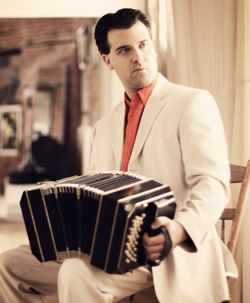by Daniel Hathaway

A large audience turned out to hear a varied program of music performed by Takács, violinist Michelle Abraham, cellists James Jaffee and Fedor Amosov and pianists Gregory Wang and Aleander Kostritsa, with a special appearance by Detroit accordionist and bandoneónist Julian Labro.
The concert took place in the village Council Chambers, a large octagonal room flooded with natural light and blessed with agreeable acoustics for chamber music. In her welcoming remarks, Kanter revealed one of the vicissitudes of her role as concert impresario: the musicians always decide to change the repertory or twiddle with the order of their pieces after the program has gone off to the printers!
That made some of the extensive program notes (by Robert Villarreal) irrelevant, but the informal, salon-like ambiance of the event easily allowed for the rearranging of musical furniture, beginning with the first work — not Beethoven’s third piano trio from Opus 1, but the second, stylishly played by Abraham, Jaffee and Takács.
Gregory Wang, a recent Oberlin graduate, made two impressive solo appearances, the first to play scintillating movements from Ravel’s Le Tombeau de Couperin, the second for the dark and introspective Ginastera Danza and the irrepressible Louis Moreau Gottschalk’s Suis moi! and Tournament Galop.
In between, the Russian cellist and pianist team of Amosov and Kostritsa tossed off Moszkowski’s Guitarre and Popper’s Hungarian Rhapsody in bravura style.
The rest of the afternoon centered on Julian Labro, who replaced a movement of Molique’s Sonata for Concertina and Piano and an arrangement of Franck’s Prélude, Fugue et Variation with Fauré’s Sicilienne, expressively played on a 1940’s, end-blown French instrument called the Accordina, then took up the bandoneón and joined Takács for Piazzolla’s Tango Ballet.
You have to have spent a large swath of your life in Buenos Aires to play Tango like a native, but the French-born Labro does an excellent job with that elusive style. For those who might be inspired to rush out and take up the bandoneón, Labro gave a sobering demonstration, noting what the irrationally-arranged buttons did on each side of the instrument and warning that each one played a different note depending on whether the bellows was being compressed or expanded.
The grand finale brought all the instrumentalists plus Peter Takács back to the stage to play Labro’s arrangement of the fascinating Fuga y misterio from Piazzolla’s Maria de Buenos Aires.
The afternoon of brilliant music-making was followed by an elaborate reception. M.U.S.i.C. presents several events each season. For details, visit the organization’s Web site.
Published on ClevelandClassical.com November 5, 2013
Click here for a printable version of this article.



